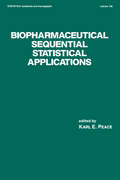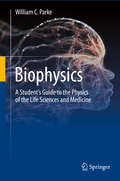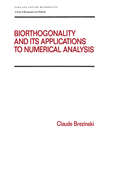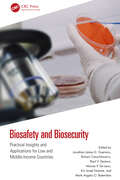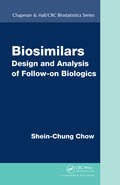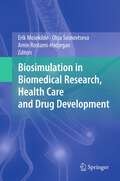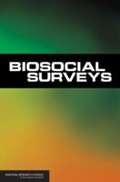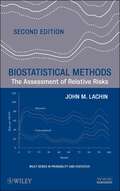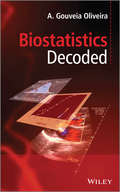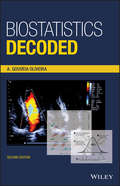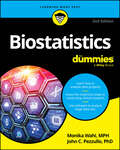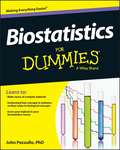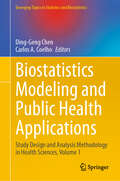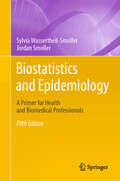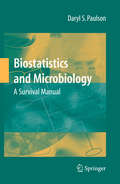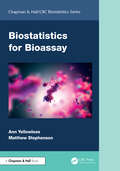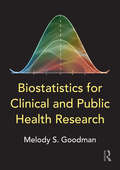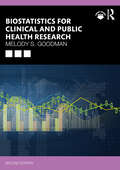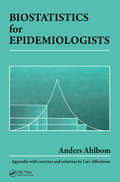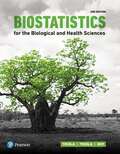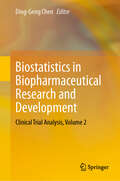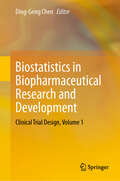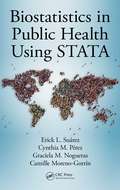- Table View
- List View
Biopharmaceutical Sequential Statistical Applications (Statistics: A Series of Textbooks and Monographs)
by Karl E. PeaceFocusing on group sequential procedures, summarizes the sequential statistical methods used in anticancer, antiviral, cardiovascular, and gastrointestinal drug research and screening. The clinical and preclinical applications are mainly presented as case studies, many of which form part of New Drug
Biophysics: A Student’s Guide to the Physics of the Life Sciences and Medicine
by William C. ParkeThis comprehensive and extensively classroom-tested biophysics textbook is a complete introduction to the physical principles underlying biological processes and their applications to the life sciences and medicine. The foundations of natural processes are placed on a firm footing before showing how their consequences can be explored in a wide range of biosystems. The goal is to develop the readers’ intuition, understanding, and facility for creative analysis that are frequently required to grapple with problems involving complex living organisms. Topics cover all scales, encompassing the application of statics, fluid dynamics, acoustics, electromagnetism, light, radiation physics, thermodynamics, statistical physics, quantum biophysics, and theories of information, ordering, and evolutionary optimization to biological processes and bio-relevant technological implementations. Sound modeling principles are emphasized throughout, placing all the concepts within a rigorous framework. With numerous worked examples and exercises to test and enhance the reader’s understanding, this book can be used as a textbook for physics graduate students and as a supplementary text for a range of premedical, biomedical, and biophysics courses at the undergraduate and graduate levels. It will also be a useful reference for biologists, physicists, medical researchers, and medical device engineers who want to work from first principles.
Biorthogonality and its Applications to Numerical Analysis (Chapman And Hall/crc Pure And Applied Mathematics Ser. #156)
by Claude BrezinskiThis book explores the use of the concept of biorthogonality and discusses the various recurrence relations for the generalizations of the method of moments, the method of Lanczos, and the biconjugate gradient method. It is helpful for researchers in numerical analysis and approximation theory.
Biosafety and Biosecurity: Practical Insights and Applications for Low and Middle-Income Countries
by Jonathan Jaime G. Guerrero, Rohani Cena-Navarro, Raul V. Destura, Marian P. De Leon, Kin Israel R. Notarte, and Mark Angelo O. BalendresThere are many guidelines, protocols and advisories that outline how biosafety and biosecurity can be adopted by institutions around the world. Whilst helpful, many of these are tailored to affluent Western nations. This leaves developing nations far behind since their laboratories and institutions are resource-scarce and biosafety and biosecurity are not mainstreamed entirely among the different laboratory workers, healthcare professionals, researchers, and academics. Biosafety and Biosecurity: Practical Insights and Applications for Low and Middle-Income Countries aims to bridge this gap by comprehensively summarizing the state and development of biosafety and biosecurity in developing and developed nations in a comparative analysis. This book includes basic concepts and principles of biosafety and biosecurity, including certification and legal frameworks, both international and local, and biosafety and biosecurity across disciplines including environmental, medical, and special topics that are relevant to countries with comparable conditions. This proposed book solves the problem of the lack of a prescribed professional title that comprehensively summarizes the state and development of biosafety and biosecurity throughout the world, allowing the reader a 360 view of the subject area.This book will appeal to a global audience of biorisk officers, health and safety professionals and specialists in the life sciences, health and allied fields, environmental science, engineering, and plant and animal agriculture.
Biosecurity: A Systems Perspective (A life skills manual)
by Andrew P. Robinson Susan M. Hester Lucie M. Bland Edith Arndt Sana Bau James S. Camac Evelyn Mannix Raphaël TrouvéBiosecurity: A Systems Perspective provides an overview of biosecurity as a system of related components, actors, and risks. This book—directed to the biosecurity practitioner, generalist scientist, and student—introduces overall features of the biosecurity system while walking the reader through the most up-to-date research on each step of the continuum (i.e. pre-border, border, and post-border activities). This book, which explicitly incorporates economic and social dimensions as well as varied decision-making contexts, paves the way for a more systemic approach to biosecurity risk management. The work spans statistics, ecology, mathematics, economics, veterinary science, human medicine, and sociology, involving collaborators across government, academia, and the private sector. This book uses a broad definition of biosecurity, rather than solely focusing on plant health, animal health, security, or one step of the biosecurity system (e.g. surveillance). As such, this book is a one-stop shop for readers interested in all aspects of biosecurity. The content and language are accessible to a wide range of audiences, including generalist scientists, biosecurity practitioners, and graduate students. More complex content is introduced in standalone boxes or chapters. The book follows a clear, simple structure within and among chapters (i.e. following the structure of the biosecurity system), making it a preferred option for graduate students. This book introduces novel cross-cutting themes, such as the importance of economic efficiency and institutional and social factors, going beyond the traditional science-based approach to biosecurity. Written in partnership with government agency practitioners, this book uses on-the-ground case studies to demonstrate how biosecurity principles are applied in practice. The book addresses challenges common to regulators in general, namely efficient regulation in uncertain and rapidly changing environments with multiple stakeholders who have—at times—conflicting priorities. Chapters 6, 7, 8, 9 and 14 are available to read Open Access via Creative Commons Attribution-No Derivatives (CC-BY-ND) 4.0, at https://www.taylorfrancis.com/books/edit/10.1201/9781003253204/.
Biosimilar Clinical Development: Scientific Considerations and New Methodologies (Chapman & Hall/CRC Biostatistics Series)
by Kerry B. Barker Sandeep M. Menon Siyan Xu Bo Jin Ralph B. D’Agostino Sr.Biosimilars have the potential to change the way we think about, identify, and manage health problems. They are already impacting both clinical research and patient care, and this impact will only grow as our understanding and technologies improve. Written by a team of experienced specialists in clinical development, this book discusses various potential drug development strategies, the design and analysis of pharmacokinetics (PK) studies, and the design and analysis of efficacy studies.
Biosimilars: Design and Analysis of Follow-on Biologics
by Shein-Chung ChowAs many biological products face losing their patents in the next decade, the pharmaceutical industry needs an abbreviated regulatory pathway for approval of biosimilar drug products, which are cost-effective, follow-on/subsequent versions of the innovator's biologic products. But scientific challenges remain due to the complexity of both the manuf
Biosimulation in Biomedical Research, Health Care and Drug Development
by Olga Sosnovtseva Amin Rostami-Hodjegan Erik MosekildeBiosimulation is an approach to biomedical research and the treatment of patients in which computer modeling goes hand in hand with experimental and clinical work. Constructed models are used to interpret experimental results and to accumulate information from experiment to experiment. This book explains the concepts used in the modeling of biological phenomena and goes on to present a series of well-documented models of the regulation of various genetic, cellular and physiological processes. The way how the use of computer models allows optimization of cancer treatment for individual patients is discussed and models of interacting nerve cells that can be used to design new treatments for patients with Parkinson's disease are explained. Furthermore this volume provides an overview on the use of models in industry, and presents the view of regulatory agencies on the topic.
Biosocial Surveys
by National Research Council of the National AcademiesBiosocial Surveys analyzes the latest research on the increasing number of multipurpose household surveys that collect biological data along with the more familiar interviewer–respondent information. This book serves as a follow-up to the 2003 volume, Cells and Surveys: Should Biological Measures Be Included in Social Science Research? and asks these questions: What have the social sciences, especially demography, learned from those efforts and the greater interdisciplinary communication that has resulted from them? Which biological or genetic information has proven most useful to researchers? How can better models be developed to help integrate biological and social science information in ways that can broaden scientific understanding? This volume contains a collection of 17 papers by distinguished experts in demography, biology, economics, epidemiology, and survey methodology. It is an invaluable sourcebook for social and behavioral science researchers who are working with biosocial data.
Biostatistical Methods
by John M. LachinPraise for the First Edition". . . an excellent textbook . . . an indispensable reference for biostatisticians and epidemiologists."--International Statistical InstituteA new edition of the definitive guide to classical and modern methods of biostatisticsBiostatistics consists of various quantitative techniques that are essential to the description and evaluation of relationships among biologic and medical phenomena. Biostatistical Methods: The Assessment of Relative Risks, Second Edition develops basic concepts and derives an expanded array of biostatistical methods through the application of both classical statistical tools and more modern likelihood-based theories. With its fluid and balanced presentation, the book guides readers through the important statistical methods for the assessment of absolute and relative risks in epidemiologic studies and clinical trials with categorical, count, and event-time data.Presenting a broad scope of coverage and the latest research on the topic, the author begins with categorical data analysis methods for cross-sectional, prospective, and retrospective studies of binary, polychotomous, and ordinal data. Subsequent chapters present modern model-based approaches that include unconditional and conditional logistic regression; Poisson and negative binomial models for count data; and the analysis of event-time data including the Cox proportional hazards model and its generalizations. The book now includes an introduction to mixed models with fixed and random effects as well as expanded methods for evaluation of sample size and power. Additional new topics featured in this Second Edition include:Establishing equivalence and non-inferiorityMethods for the analysis of polychotomous and ordinal data, including matched data and the Kappa agreement indexMultinomial logistic for polychotomous data and proportional odds models for ordinal dataNegative binomial models for count data as an alternative to the Poisson modelGEE models for the analysis of longitudinal repeated measures and multivariate observationsThroughout the book, SAS is utilized to illustrate applications to numerous real-world examples and case studies. A related website features all the data used in examples and problem sets along with the author's SAS routines.Biostatistical Methods, Second Edition is an excellent book for biostatistics courses at the graduate level. It is also an invaluable reference for biostatisticians, applied statisticians, and epidemiologists.
Biostatistics Decoded
by A. Gouveia OliveiraStudy design and statistical methodology are two important concerns for the clinical researcher. This book sets out to address both issues in a clear and concise manner. The presentation of statistical theory starts from basic concepts, such as the properties of means and variances, the properties of the Normal distribution and the Central Limit Theorem and leads to more advanced topics such as maximum likelihood estimation, inverse variance and stepwise regression as well as, time-to-event, and event-count methods. Furthermore, this book explores sampling methods, study design and statistical methods and is organized according to the areas of application of each of the statistical methods and the corresponding study designs. Illustrations, working examples, computer simulations and geometrical approaches, rather than mathematical expressions and formulae, are used throughout the book to explain every statistical method. Biostatisticians and researchers in the medical and pharmaceutical industry who need guidance on the design and analyis of medical research will find this book useful as well as graduate students of statistics and mathematics with an interest in biostatistics. Biostatistics Decoded: Provides clear explanations of key statistical concepts with a firm emphasis on practical aspects of design and analysis of medical research. Features worked examples to illustrate each statistical method using computer simulations and geometrical approaches, rather than mathematical expressions and formulae. Explores the main types of clinical research studies, such as, descriptive, analytical and experimental studies. Addresses advanced modeling techniques such as interaction analysis and encoding by reference and polynomial regression.
Biostatistics Decoded
by A. Gouveia OliveiraBiostatistics Decoded covered a large number of statistical methods that are mainly applied to clinical and epidemiological research, as well as a comprehensive discussion of study designs for observational research and clinical trials, two important concerns for the clinical researcher. In this second edition, new material is included covering statistical methods and study designs that are used to analyse research. Following the same methodology used in the first edition, the chapters are presented in two levels of detail, one for the reader who wishes only to understand the rationale behind each statistical method, and one for the reader who wishes to understand the computations Key features include: Extensive coverage of the design and analysis of experiments for basic science research Experimental designs are presented together with the statistical methods The rationale of all forms of ANOVA is explained with simple mathematics A comprehensive presentation of statistical tests for multiple comparisons Calculations for all statistical methods are illustrated with examples and explained step-by-step. This book presents biostatistical concepts and methods in a way that is accessible to anyone, regardless of his or her knowledge of mathematics. The topics selected for this book cover will meet the needs of clinical professionals to readers in basic science research.
Biostatistics For Dummies
by Monika Wahi John C. PezzulloBreak down biostatistics, make sense of complex concepts, and pass your class If you're taking biostatistics, you may need or want a little extra assistance as you make your way through. Biostatistics For Dummies follows a typical biostatistics course at the college level, helping you understand even the most difficult concepts, so you can get the grade you need. Start at the beginning by learning how to read and understand mathematical equations and conduct clinical research. Then, use your knowledge to analyze and graph your data. This new edition includes more example problems with step-by-step walkthroughs on how to use statistical software to analyze large datasets. Biostatistics For Dummies is your go-to guide for making sense of it all. Review basic statistics and decode mathematical equations Learn how to analyze and graph data from clinical research studies Look for relationships with correlation and regression Use software to properly analyze large datasets Anyone studying in clinical science, public health, pharmaceutical sciences, chemistry, and epidemiology-related fields will want this book to get through that biostatistics course.
Biostatistics For Dummies
by PezzulloScore your highest in biostatisticsBiostatistics is a required course for students of medicine, epidemiology, forestry, agriculture, bioinformatics, and public health. In years past this course has been mainly a graduate-level requirement; however its application is growing and course offerings at the undergraduate level are exploding. Biostatistics For Dummies is an excellent resource for those taking a course, as well as for those in need of a handy reference to this complex material. Biostatisticians--analysts of biological data--are charged with finding answers to some of the world's most pressing health questions: how safe or effective are drugs hitting the market today? What causes autism? What are the risk factors for cardiovascular disease? Are those risk factors different for men and women or different ethnic groups? Biostatistics For Dummies examines these and other questions associated with the study of biostatistics.Provides plain-English explanations of techniques and clinical examples to help Serves as an excellent course supplement for those struggling with the complexities of the biostatisticsTracks to a typical, introductory biostatistics courseBiostatistics For Dummies is an excellent resource for anyone looking to succeed in this difficult course.
Biostatistics Modeling and Public Health Applications: Study Design and Analysis Methodology in Health Sciences, Volume 1 (Emerging Topics in Statistics and Biostatistics)
by Ding-Geng Chen Carlos A. CoelhoThis book provides an overview and compilation of contemporary topics and innovative approaches in biostatistical modeling through their applications to evidence-based public health research and decision-making. This book covers topics in 3 parts as: 1) Biostatistical Modeling, 2) Imaging Data Analysis, and 3) Public Health Applications. Topics should appeal to both expert statisticians, as well as health researchers interested in biostatistical methodological applications in evidence-based health research. The book is a resourceful manual and can be used as an authoritative reference. The features covered in this book will appeal to researchers where public health research is being rigorously conducted.
Biostatistics and Epidemiology: A Primer for Health and Biomedical Professionals
by Jordan Smoller Sylvia Wassertheil-SmollerThis book teaches foundations of epidemiological design and statistical methods, as well as including topics applicable to new areas of research. Since the publication of the first edition, Biostatistics and Epidemiology has attracted loyal readers from various specialty areas in the biomedical community. The Fifth Edition includes coverage of fixed and random effects and mixed effects models; Poisson regression; constructing confidence intervals for U-shaped relationships; analysis of rare variants; Mendelian randomization; and aspects of machine learning and big data analytics. Biostatistics and Epidemiology was written to be accessible for readers without backgrounds in mathematics. It provides clear explanations of underlying principles, as well as practical guidelines of "how to do it" and "how to interpret it." Key features include a philosophical and logical explanation at the beginning of the book, subsections that can stand alone or serve as reference, cross-referencing, recommended reading, and appendices covering sample calculations for various statistics in the text.
Biostatistics and Microbiology: A Survival Manual
by Daryl S. PaulsonThis "nuts and bolts" book provides a condensation of biostatistical methods that applied microbiology researchers need to perform data analyses. Based on the author's more than two decades of applied research and teaching experience, it is presented in a straight-forward manner, applicable by practicing microbiologists with minimal backgrounds in mathematics. All methods rely only on the use of a basic hand-held calculator. The overriding goal of this book is to ground one's microbiological expertise and experience in one's research pursuits, using biostatistics not as a black box, but as a tool.
Biostatistics for Bioassay (Chapman & Hall/CRC Biostatistics Series)
by Matthew Stephenson Ann YellowleesIn recent decades, there has been enormous growth in biologics research and development, with the accompanying development of biological assays for emerging products. In parallel, there have been substantial advances in statistical methodology, as well as technological advances in computer power, enabling new techniques to be implemented via statistical software. Biostatistics for Bioassay presents an overview of the statistical analysis techniques that are needed in order to report the results of biological assays. These assays are needed for testing all biological medicines, such as vaccines and cell therapies, to allow them to be released for use. Beginning with consideration of the performance characteristics required of a bioassay, including accuracy, precision, and combinations of these two attributes, the book builds a framework for statistical bioassay design.Features: Explains the statistical methods needed at each stage of the lifecycle of a bioassay Describes the demonstration of the bioassay’s performance, known as validation Covers the statistical techniques for monitoring the bioassay’s performance over time Details how to transfer the bioassay to another laboratory or replace critical reagents Provides examples at every stage, to allow the reader to work through the techniques and consolidate their understanding The book provides a resource for interested bioassay analysts, and statisticians working with bioassays. In bringing together best practices in statistics across the bioassay lifecycle into a single volume, it aims to provide a comprehensive and useful textbook for statistical analysis in bioassay.
Biostatistics for Clinical and Public Health Research
by Melody S. GoodmanBiostatistics for Clinical and Public Health Research provides a concise overview of statistical analysis methods. Use of SAS and Stata statistical software is illustrated in full, including how to interpret results. Focusing on statistical models without all the theory, the book is complete with exercises, case studies, take-away points, and data sets. Readers will be able to maximize their statistical abilities in hypothesis testing, data interpretation, and application while also learning when and how to consult a biostatistician. This book will be an invaluable tool for students and clinical and public health practitioners.
Biostatistics for Clinical and Public Health Research
by Melody S. GoodmanThe new edition of Biostatistics for Clinical and Public Health Research is an introductory workbook to provide not only a concise overview of key statistical concepts but also step-by-step guidance on how to apply these through a range of software packages, including R, SAS, and Stata.Providing a comprehensive survey of essential topics – including probability, diagnostic testing, probability distributions, estimation, hypothesis testing, correlation, regression, and survival analysis – each chapter features a detailed summary of the topic at hand, followed by examples to show readers how to conduct analysis and interpret the results. Also including exercises and solutions, case studies, take-away points, and data sets (Excel, SAS, and Stata formats), the new edition now includes a chapter on data literacy and data ethics, as well as examples drawn from the COVID-19 pandemic.Ideally suited to accompany either a course or as support for independent study, this book will be an invaluable tool for both students of biostatistics and clinical or public health practitioners.
Biostatistics for Epidemiologists
by Anders AhlbomBiostatistics for Epidemiologists is a unique book that provides a collection of methods that can be used to analyze data in most epidemiological studies. It examines the theoretical background of the methods described and discusses general principles that apply to the analysis of epidemiological data. Specific topics addressed include statistical interference in epidemiological research, important methods used for analyzing epidemiological data, multivariate models, dose-response analysis, analysis of the interaction between causes of disease, meta-analysis, and computer programs. Biostatistics for Epidemiologists will be a useful guide for all epidemiologists and public health professionals who rely on biostatistical data in their work.
Biostatistics for The Biological and Health Sciences
by Mario F. Triola Marc M. Triola Jason RoyReal-world applications connect statistical concepts to everyday life. This book uses a variety of real-world applications to bring statistical theories and methods to life. Through these examples and a friendly writing style, the 2nd Edition ensures that you understand concepts and develop skills in critical thinking, technology, and communication. The result of collaboration between a biological sciences expert and the author of the #1 statistics book in the country, Biostatistics for the Biological and Health Sciences provides an excellent introduction to statistics for readers interested in the biological, life, medical, and health sciences.
Biostatistics in Biopharmaceutical Research and Development: Clinical Trial Analysis, Volume 2
by Ding-Geng ChenThe Deming Conference on Applied Statistics has long been deemed an influential event in the biostatistics and biopharmaceutical profession. It provides learning experience on recent developments in statistical methodologies in biopharmaceutical applications and FDA regulations. This book honors 80 years of contributions and dedication of the Deming Conference in biostatistics, and biopharmaceutical clinical trial methodology and applications. All chapters are contributed by world-class and prominent Deming speakers, who've contributed their cutting-edge research and developments to the community. Volume 2 covers Biomarkers in Drug Development, Time-To-Event Data Analysis and Methods, and emerging development in biopharmaceutical biostatistics. This book aims to booster research, education, and training in biostatistics and in biopharmaceutical research and development.
Biostatistics in Biopharmaceutical Research and Development: Clinical Trial Design, Volume 1
by Ding-Geng ChenThe Deming Conference on Applied Statistics has long been deemed an influential event in the biostatistics and biopharmaceutical profession. It provides learning experience on recent developments in statistical methodologies in biopharmaceutical applications and FDA regulations. This book honors 80 years of contributions and dedication of the Deming Conference in biostatistics, and biopharmaceutical clinical trial methodology and applications. All chapters are contributed by world-class and prominent Deming speakers, who've contributed their cutting-edge research and developments to the community. Volume 1 covers Historical Milestones in Clinical Trial Design, FDA biopharmaceutical design guidance, and emerging development in Clinical Trial Design Methodology. This book aims to booster research, education, and training in biostatistics and in biopharmaceutical research and development. Chapter "Response-adaptive Randomization Designs Based on Optimal Allocation Proportion" is available open access under a Creative Commons Attribution 4.0 International License via link.springer.com.
Biostatistics in Public Health Using STATA
by Cynthia M. Pérez Erick L. Suárez Graciela M. Nogueras Camille Moreno-GorrínStriking a balance between theory, application, and programming, Biostatistics in Public Health Using STATA is a user-friendly guide to applied statistical analysis in public health using STATA version 14. The book supplies public health practitioners and students with the opportunity to gain expertise in the application of statistics in epidemiolo
